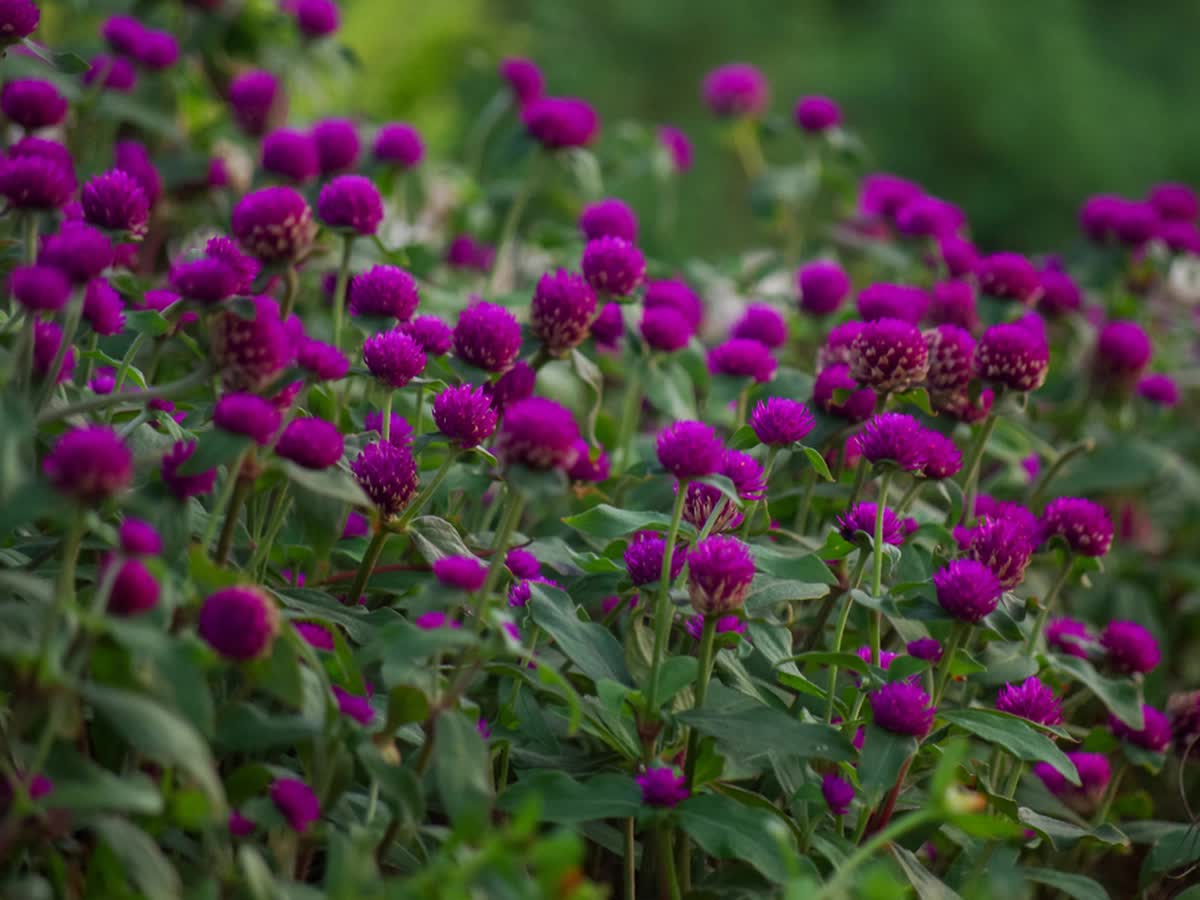How to Grow
Know Vadamalli benefits and learn how to grow them at home
The magenta colored bushy flower with a bright appearance that you often find in mixed flower bouquets is vadamalli.
Often, it is used as a symbol of undying love and immortality. Do you know why? That’s because globe amaranth, or Vadamalli, retains its color and beauty even after dying.
In a variety of foods, vadamalli is used across cultures. The most popular one is amaranth tea, which is light crimson in color.
This tea is believed to prevent the signs of aging and provide flawless skin.
Wish to learn more?
Due to its lack of gluten and ability to aid in digestion, Amarath flour is gradually becoming a staple in the US market
In this blog, we will learn about the following aspects of Vadamalli: -
- Interesting facts about Vadamalli flowers
- Types of Vadamalli flowers
- How to grow Vadamalli flowers at home
- How to take care of Vadamalli flowering plants
- Benefits of Vadamalli
So, let’s get started.
Interesting facts about Vadamali flowers
- Vadamalli is also referred to by the names Gomphrena globosa, makhmali, and Rudrakshi hoova
- It is an edible plant in the family Amaranthaceae
- The globe amaranth, or Vadamalli plant, is native to Central America, including the regions of Panama and Guatemala
- Because of its vibrant color, this Vadamalli plant is popular in landscape design
- In some cultures, it is widely eaten—as a snack, a salad or soup topping, a flavoring for smoothies, or as flour to make baked goods
- In some cultures, it is widely eaten – as a snack, salad or soup topping, flavoring smoothies, or as flour to make baked goods
- The most popular form of amaranth consumption is tea which is believed to have healing properties
- The tea made from Vadamalli is known to relieve coughing and shortness of breath and enhance vision
- It is surprising to learn that in the Guianas, this whole Vadamalli plant infusion of the white-flowered variant is used as a diabetes remedy
- Do you know that in our neighboring nation, Nepal, Vadamalli is known as Makhamali ful and a garland of this flower is used during Bhai Tika?
- The Vadamalli flowers provide betacyanins, which are used profusely in the food and cosmetic industries as a natural purple-red dye
Types of globe amaranth or Vadamalli flowers
The globe amaranth, or Vadamalli flowers come in a beautiful magenta color, but there are also other varieties of this flower that are pleasing too. They are mentioned below: -
Bicolor Rose – This variety has deep lavender colored flowers with a white cap
Strawberry Fields – It has a bright red color and is globular in structure with a papery texture. They are famous as cut flowers and are often found in mixed flower bouquets.
Purple Amaranth – This one is rich purple or magenta in color and is mostly used in cooking or soil conditioning.
Lavender Lady – This is a small group of tropical and warm-temperate flowers, and they get this name for their pseudo-spherical heads.
Fireworks – This one features sparkling pink flowers tipped with bright yellow on very long stems
How to grow Vadamalli flowers at home
- You have to first choose a location where the Vadamalli flower plant can receive full sunlight and then work on the soil.
- The pH should range from 6.1 to 7.5, and the soil can be either rich loam or clay with sufficient drainage. This plant prefers slightly acidic soil with a trace of alkalinity. You can add compost to your garden's soil to make it more acidic or lime to make it less acidic, depending on the pH of the soil there already.
- Bring seeds for vadamalli and plant them 1/8 of an inch deep in the ground. Add a few more seeds, spacing them out by 4 to 6 inches, and lightly cover them with soil.
- Give an adequate amount of water to the soil at a temperature between 21 and 25 degrees Celsius. Within one to two weeks, the seeds will begin to sprout.
- Before moving the seedlings into your outdoor garden, make sure they are strong. You should plant the seeds 6 to 8 weeks before you intend to transplant them outside in order to ensure that the seedlings are sturdy.
- Make sure the seedlings are sturdy before transplanting them into your outdoor garden. And to make the seedlings strong, you should plant the seeds 6-8 weeks before you plan to take them outside.
- In most places across India, we experience warm weather. So you can put the seeds directly into the garden soil after making the necessary modifications to the soil as indicated above.
- Just make sure the spot gets enough sunlight and the soil temperature remains around 21 degrees Celsius. Plant seeds in rows; 12 seeds per square foot are ideal. In 10–15 days, the seeds will begin to sprout.
- You could apply a fertilizer with a low nitrogen content to the soil.
- When you see one or two sets of leaves appearing from the seedlings, thin them out to a spacing of 12–18 inches.
- Water your plants carefully so that they stay healthy. One inch of water per week is good.
- Wait for at least 3 months for the Vadamalli flowers to bloom.
How to take care of Vadamalli flower plants
If you love to have flowers around but are new to the world of plants and gardening, opt for Vadamalli flowers or globe amaranth. They are easy to grow and require minimum maintenance. Take a look at these useful care tips for Vadamalli flowers: -
Water
Vadamalli is fairly drought resistant. It means it can sustain some dry spells, but remember that regular watering would promote a healthier plant. Just an inch of water per week is sufficient for this plant. And also remember to point the hose or watering can mouth at the soil and not the leaves, because that may give rise to fungal growth.
Soil
This flowering plant can grow in any average garden soil mixed with some sand for good drainage. Vadamalli would grow in heavy clay soil too, but the height would be stunted after a certain point. The soil pH should be between 6.1 and 7.5. It means an acidic soil is ideal for the growth of globe amaranth.
Sunlight
A bright sun or partial shade is ideal for the growth of Vadamalli or globe amaranth. But don’t provide too much shade, because that may reduce blooming. So, a proper amount of sunlight for 6-8 hours is great for its growth.
Location
A location in your balcony, terrace, or garden where the plant can get 6-8 hours of undisturbed sunlight followed by shade is ideal.
Temperature
Globe amaranth, or Vadamalli, grows in almost all climates but prefers warmer and wetter ones. It is thus a tropical flower, and the ideal temperature should be between 21 and 25 degrees Celsius.
Fertilizer
The Vadamalli plant doesn’t require much fertilizer. But if your plant has become weaker and has yellow leaves, you can use a high-nitrogen fertilizer to bring back the green leaves. Otheriwse, stick to organic fertilizer like compost once a while. Remember that a lot of leaves are produced when the plant is overfed. Use less fertilizer or get rid of them entirely if you want more flowers.
Benefits of Vadamalli
The globe amaranth plant and its flowers are used in many ways. The tea made from the vadamalli flowers is world-famous. Some of the amazing benefits of vadamalli are listed below:
No gray hair
The most well-known benefit of vadamalli is its ability to prevent graying of the hair. The iron content in vadamalli or globe amaranth imparts great hair. It is this mineral that helps in preventing graying of the hair.
Strengthens hair
An amino acid called lysine can make hair stronger. Application of this lysine can prevent male pattern baldness, yet intriguingly, the human body does not generate it. Vadamalli has lysine that will make your hair follicles stronger. After shampooing, it may be beneficial to apply juice made from globe amaranth leaves to the hair.
Flawless skin
Oil extracted from globe amaranth or vadamalli is a blessing for the skin. It can help remove the signs of aging. It cleanses and purifies the skin from within.
Good for the eyes
Vitamin A, which is believed to enhance vision, is abundant in globe amaranth. The vitamin is crucial for eyesight in dimly lit areas and for preventing night blindness (caused by vitamin A deficiency).
Detoxifying agent
Vadamalli is a great detoxifier. If you want to purify your body by flushing out toxins, you may consume some amaranth tea. Research says, it can be used for treating gallstones, cough, and oliguria (low urine conditions).
Antibacterial in nature
Vadamallit has excellent antibacterial qualities. Clinical studies have shown that this plant has antibacterial effects against bacteria like Bacillus cereus and Staphylococcus aureus.
Maintaining blood pressure
The oil present in vadamalli flowers has been helpful in treating people with hypertension and cardiovascular diseases. Moderate consumption of vadamalli can reduce cholesterol. Apart from balancing blood pressure, vadamalli tea can also boost immunity.
Aids in digestion and maintains a good heart
Do you know that around 78% of the fiber in vadamalli is insoluble while the rest, 22%, is soluble? This ratio is higher than what is typically found in wheat or maize. This fiber subsequently aids in binding cholesterol in the digestive tract, which causes elimination of the waste. So essentially, the fiber functions as bile and extracts the cholesterol from the stool. This promotes healthy cardiac function and digestion.
In addition to all of these benefits, vadamalli is a well-known source of vitamins E and C that can help battle fatigue. But before jumping into using them, kindly consult your doctor for proper guidance.
Beautiful and useful—aren't those the two best words to describe vadamalli flowers? The gorgeous flowers would simply dazzle your home. As it is easy to grow and care for, you can plan to plant one soon.
FAQ’s related to Vadamalli
Is it possible to grow Vadamalli in pots?
Yes, you can grow Vadamalli in pots. Just make sure that the pot is at least 24 inches deep because this plant grows taproots.
How many days do Vadamalli flowers take to grow?
The Vadamalli flowers take between 85 and 100 days to grow.
What is the English name of Vadamalli?
Vadamalli is known as globe amaranth in English.
What is amaranth tea good for?
Amaranth tea is good for flawless skin, strong hair, reducing coughs, and boosting immunity.
What is the smell of vadamalli flowers?
Vadamalli flowers have almost no scent. But when crushed, they may smell like radish roots.
Does amaranth or vadamalli bloom in summer in India?
Vadamalli blooms throughout the summer and early fall in India. So, basically, from June to September, you will see vadamalli blooming.



